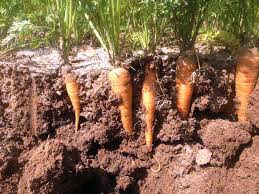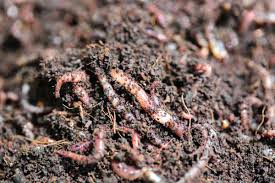Make Soil Microbes Your Friends
By Marsha Goldberg, Fairfax Master Gardener
 Most gardeners know the aphorism, “Take care of your soil and the soil will take care of the plants.” By providing needed nutrients, healthy soil results in plants that are more likely to thrive and fight off disease and pests without the use of chemical fertilizers, insecticides and fungicides. But what exactly is a healthy soil, and how can the home gardener achieve it?
Most gardeners know the aphorism, “Take care of your soil and the soil will take care of the plants.” By providing needed nutrients, healthy soil results in plants that are more likely to thrive and fight off disease and pests without the use of chemical fertilizers, insecticides and fungicides. But what exactly is a healthy soil, and how can the home gardener achieve it?
In the past, scientists and gardeners thought of soil in terms of the presence or absence of macronutrients — nitrogen, phosphorus and potassium — as well as micronutrients such as magnesium and iron. Correcting the balance of the soil involved adding fertilizers and other chemicals, whether organic or synthetic. Now, however, soil scientists are turning their attention to the living matter, especially the microbes, that live in the soil – microbes that include bacteria, fungi, nematodes, protozoa, and earthworms. Ninety percent of soil functions are due to the activity of microbes. These microbes affect the texture of the soil but also have an impact on its chemical balance. Their activity creates tunnels and pores that help the soil absorb and retain water as well as hold oxygen, making it available to plants. Just as important, microbes have a symbiotic relationship with plants, especially the roots. Microbes eat and digest waste products emitted by plants. The microbes, in turn, produce their own waste, which contains nitrogen compounds. Plants take this up when the microbes digest, die and eventually decompose.

earthworms
The Natural Resources Conservation Service (NRCS), a division of the U.S. Department of Agriculture has implemented a program to help farmers achieve healthy soil by harnessing and supporting the activity of microbes. The key goal of the program includes teaching farmers to take advantage of natural ecological processes to restore soil structure, cycle organic nutrients, and retain water in their fields. Home gardeners can easily adapt many of these strategies to their own soil.
Soil is composed mostly of minerals in sand, silt and clay, with a small amount of organic matter. However, about 50 percent is space filled by air, gas or water, and this is where microbes thrive. Good soil contains up to a ton of soil microbes per acre. The majority of these are beneficial so, for a well-balanced soil, diversity is important so that no one type gets out of control. Microbes are the gardener’s allies, and it is important that the gardener feeds them and insures their health. The NRCS recommends that farmers and gardeners take several steps to improve soil health on a long-term, permanent basis.
- Keep the soil covered as much as possible. Covering the soil helps it retain moisture, discourage weeds, minimize erosion and reduce the effects of fluctuations in temperature. Soil can be covered with mulches and plant debris such as hay or leaf mold, but important effects can be achieved by keeping the soil continuously planted with succession crops or, especially helpful, with cover crops. Rather than depleting the nutrients in the soil with continuous planting, keeping the soil covered and then turning the crop waste in, or composting it and adding the compost to the soil, will recycle the nutrients and feed the microbes.
- Consider the use of cover crops. Many different types are available so you can choose one or more — they often come in mixes — that have specific benefits to meet your soil’s needs. Some, such as alfalfa and clover, have deep roots. Their roots reach and pull up nutrients that are deep down, loosen soil that is hard and compacted, and create tunnels that absorb water and oxygen, while creating living spaces for microbes. Others, especially those in the legume family, pull nitrogen from the air and fix it in the soil, making it available to plants that follow. Most cover crops suppress weeds and prevent erosion, and almost all can be turned into the soil to provide a green manure, enriching the soil with organic matter. As a home gardener, however, be aware of how to manage the particular cover crop you choose. Buckwheat and clover, for example, should be cut back before flowering so they do not reseed. Rye should be cut back and forked in before it becomes firmly rooted in the soil and difficult to turn. Many cover crops, however, can simply be cut and left on the soil to decompose while you plant later crops right through them.
- Disturb the soil as little as possible. Formerly, growers believed that soils needed to be loosened and mixed to distribute nutrients and create seedbeds. However, research shows that tillage exposes organic matter to the air where it is consumed by bacteria and lost to the environment as carbon dioxide. Soil that is tilled retains only 30-40 percent of the organic matter of undisturbed soil. Soil that is disturbed through excess tillage — which destroys the tunnels and spaces created by microbes when equipment is rolled on it or when growers step on it — becomes compacted so water runs off instead of being absorbed. The soil can dry out and grow more vulnerable to erosion. Tillage exposes weed seeds and allows them to germinate as well as buries crop residues that naturally retard weed growth. The NRCS recommends that growers till as little as possible or give it up altogether, letting natural processes achieve the same effect.
- Rotate your crops. We all know that we need to rotate crops when possible to discourage the persistence of plant specific diseases and pests. Rotating crops also provides a diverse diet for microbes so that the many different types are getting the nutrients they need and can flourish in a balanced environment. According to the NRCS, a single crop is like a “donut diet” for soil.
- As much as possible, reduce the use of chemicals that are detrimental to microorganisms. Pesticides kill insects but will also kill microbes and beneficial insects. Fertilizers contain salts that are detrimental to microbes, build up in the soil, and ultimately result in soil that is less beneficial to plant health. Healthy soil will nourish plants, making them less dependent on fertilizer, and result in plants that can fight disease through natural processes. Learn how to attract beneficial insects to your garden and use physical barriers such as row covers.
So take some cues from what farmers are doing to improve their soils and increase their productivity. By modifying your own practices accordingly, you can create the healthiest soil on your block.
Resources
• Explore the Science of Soil Health (videos),Natural Resources Conservation Service, U.S. Department
of Agriculture
• Healthy Soil, Healthy Plants!, University of Minnesota Extension
• Building Healthy Soils, Tennessee Department of Agriculture Extension
• Let’s Not Keep the Importance of Soil Health a Secret! Virginia Cooperative Extension